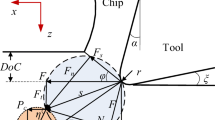Abstract
Residual stresses generated in cutting process have important influences on workpiece performance. The paper presents a method of theoretical analysis in order to explicate the formation mechanism of residual stresses in cutting. An important conclusion is drawn that the accumulated plastic strain is the main factor which determines the nature and the magnitude of surface residual stresses in the workpiece. On the basis of the analytical model for residual stress, a series of simulations for residual stress prediction during cutting AISI 1045 steel are implemented in order to obtain the influences of cutting speed, depth of cut and tool edge radius on surface residual stress in the workpiece. And these influences are explained from the perspective of formation mechanism of residual stress in cutting. The conclusions have good applicability and can be used to guide the parameters selection in actual production.
Similar content being viewed by others
References
Capello E. Residual stresses in turning: Part I: Influence of process parameters. Journal of Materials Processing Technology, 2005, 160(2): 221–228
Säi W B, Salah N B, Lebrun J L. Influence of machining by finishing milling on surface characteristics. International Journal of Machine Tools & Manufacture, 2001, 41(3): 443–450
Sridhar B R, Devananda G, Ramachandra K, Bhat R. Effect of machining parameters and heat treatment on the residual stress distribution in titanium alloy IMI-834. Journal of Materials Processing Technology, 2003, 139(1–3): 628–634
El-Axir M H. A method of modelling residual stress distribution in turning for different materials. International Journal of Machine Tools & Manufacture, 2002, 42(9): 1055–1063
Rech J, Moisan A. Surface integrity in finish hard turning of casehardened steels. International Journal of Machine Tools & Manufacture, 2003, 43(5): 543–550
Mantle A L, Aspinwall D K. Surface integrity of a high speed milled gamma titanium aluminide. Journal of Materials Processing Technology, 2001, 118(1–3): 143–150
Genzel C, Klaus M, Denks I, Wulz H G. Residual stress fields in surfacetreated silicon carbide for space industry—comparison of biaxial and triaxial analysis using different X-ray methods. Materials Science and Engineering A, 2005, 390(1–2): 376–384
Quan Y, Ye B. The effect of machining on the surface properties of SiC/Al composites. Journal of Materials Processing Technology, 2003, 138(1–3): 464–467
Su J C. Residual stress modeling in machining processes. Dissertation for the Doctoral Degree. Atlanta: Georgia Institute of Technology, 2006
McDowell D L. An approximate algorithm for elastoplastic twodimensional rolling/sliding contact. Wear, 1997, 211(2): 237–246
Merwin J E, Johnson K L. An analysis of plastic deformation in rolling contact. Proceedings of the Institution of Mechanical Engineers, 1963, 177(1): 676–690
Jiang Y, Sehitoglu H. An analytical approach to elastic-plastic stress analysis of rolling contact. Journal of Tribology, 1994, 116(3): 577–587
Ulutan D, Erdem Alaca B, Lazoglu I. Analytical modelling of residual stresses in machining. Journal of Materials Processing Technology, 2007, 183(1): 77–87
Lazoglu I, Ulutan D, Alaca B E, et al. An enhanced analytical model for residual stress prediction in machining. CIRP Annals-Manufacturing Technology, 2008, 57(1): 81–84
Komanduri R, Hou Z B. Thermal modeling of the metal cutting process: Part I—Temperature rise distribution due to shear plane heat source. International Journal of Mechanical Sciences, 2000, 42(9): 1715–1752
Jaspers S P F C, Dautzenberg J H. Material behaviour in conditions similar to metal cutting: flow stress in the primary shear zone. Journal of Materials Processing Technology, 2002, 122(2–3): 322–330
Author information
Authors and Affiliations
Corresponding author
Rights and permissions
About this article
Cite this article
Qi, Z., Li, B. & Xiong, L. The formation mechanism and the influence factor of residual stress in machining. Front. Mech. Eng. 9, 265–269 (2014). https://doi.org/10.1007/s11465-014-0311-0
Received:
Accepted:
Published:
Issue Date:
DOI: https://doi.org/10.1007/s11465-014-0311-0




